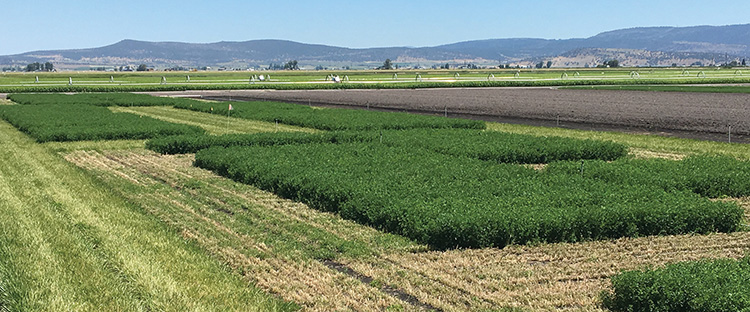
This year has been a year to remember for Western alfalfa producers — or quite possibly one that many would prefer to forget. Record-high hay prices in 2014 slid significantly in 2015, and now this year took a huge dive to prices so low they seemed more like those from decades ago rather than the 2010s.
As is often the case, there is a larger difference between Premium and Supreme quality alfalfa and lower hay quality grades in a depressed market. This was true in spades this year. Sometimes the price spread in California was even greater than $100 per ton, and at times Supreme quality hay was worth twice as much as Fair quality hay. As a rule, the price spread has not been as great in other Western states, but there has still been a large premium for high-quality hay. Not only has the price been so much lower for mediocre-quality hay, but sales have been sluggish at nearly any price.
The cutting schedule, or more precisely how frequently the alfalfa is cut, has a greater influence on forage quality than any other factor under the grower’s control. It strongly impacts the overall profitability of an alfalfa operation because of its direct effect on yield and forage quality. As alfalfa growers are well aware, more frequent cutting results in higher forage quality but lower yield per cutting.
Paying the price
So, in a year like this with such a large premium for high forage quality, the incentive has been great for growers to use a short interval between cuttings. Further, in many areas of the West, it was a mild winter with fewer spring frosts, which got the alfalfa off to an earlier than normal start. This coupled with the economic incentive to produce top-quality hay resulted in many producers taking an extra cutting this year.
There is a price to pay when it comes to continually cutting alfalfa on a short interval. An extra cutting over the season not only results in lower yields per cutting, but oftentimes there is lower seasonal yield as well. Research conducted in northern California and in the Central Valley illustrates this point. Years of cutting schedule research in the northern intermountain area compared a 3-cut versus a 4-cut schedule. In most years, a 3-cut schedule resulted in higher seasonal yield but significantly lower forage quality.
Similarly, research conducted in the Central Valley of California by Dan Putnam, University of California forage specialist, compared cutting alfalfa every 24 to 26 days (8 cuts per year), a 28-day schedule (7 cuts per year), and a 32-day cutting interval (6 cuts per year). Total seasonal yield for the 6-cut, 7-cut, and 8-cut schedules averaged over the three years of the study was 11.45, 9.92, and 9.32 tons per acre, respectively. Not only might total-season yield be affected, but the vigor of the alfalfa plant is reduced, which long term can affect stand persistence.
Along with other alfalfa researchers across the U.S., we currently have a trial in the intermountain area comparing different cutting intervals for both reduced lignin and standard alfalfa. Alfalfa is cut on 28-, 33-, and 38-day schedules. The difference in alfalfa vigor at the end of the season is impressive. Compared with alfalfa cut on a 28-day schedule, the alfalfa cut on a 38-day schedule is significantly taller in the fall despite its final cutting of the season occurring two days later.
So . . . what’s a grower to do?
Delay a summer cutting
When trying to improve profits in a depressed market, a grower who sells their hay off-farm doesn’t have much choice but to cut frequently to secure a higher price and to ensure that their hay sells. One strategy to consider is to let one of the cuttings go longer to allow the plant to store more carbohydrate reserves in the root and crown. Repeated cutting of alfalfa in an early bud or even prebud stage without a break significantly weakens the plant; this reduces plant vigor and escalates the plant’s susceptibility to pests such as diseases and insects.
A logical approach is to allow one of the midsummer cuttings to mature. It’s always challenging to produce top dairy quality alfalfa in midsummer even under the best of conditions. In response to the higher temperatures, alfalfa grows more rapidly, but the quality is significantly lower as the internode length (distance between leaf nodes on the stem) is typically greater and the stem usually has a higher fiber and lignin content. Since it is so difficult to produce dairy quality anyway in the heat of summer, why not allow a little extra time for the plant to restore its root reserves for a single cutting on at least some fields?
The effects of a very aggressive cutting schedule do not only impact production and vigor that year, but they carry over into subsequent years as well. We have observed a one-quarter to one-half ton per-acre yield difference in the first cutting alone in the following year. Therefore, growers should pay close attention to the vigor of different fields as they break dormancy after this coming winter.
First, cut those fields exhibiting the most vigor and growth. Leave those fields that lag behind because they were cut more aggressively this year until the end of the cutting cycle. This will allow these fields more time to recover and build up carbohydrate reserves.
This article appeared in the November 2016 issue of Hay & Forage Grower on pages 26 and 27.
Not a subscriber? Click to get the print magazine.

